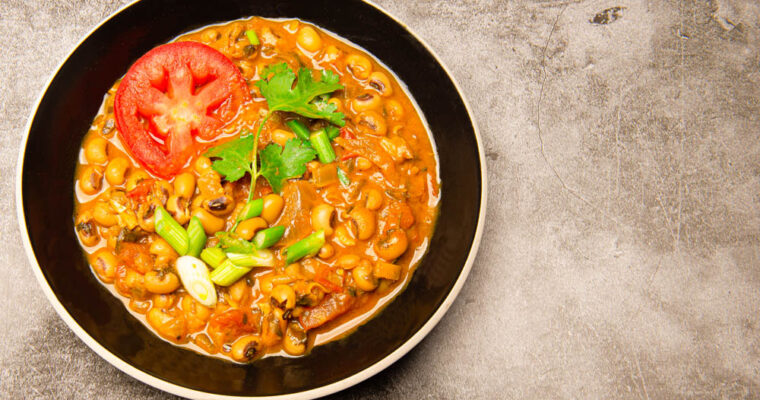OK everyone. All together now. Say cowpeas.
That’s what black-eyed peas are. They are a type of cowpeas, “one of the most ancient crops known to man” according to Purdue’s horticultural Jefferson Institute, and the real shocker is that they aren’t really peas at all. Instead, they are an African relative of the mung bean. Who knew?
Cowpeas are believed to have been introduced to the United States via the slave trade. And, as the story goes, the consumption of black-eyed cowpeas later became a New Year’s day tradition in the South as a result of the Civil War. According to Texas A and M’s website, the 40-day siege of Vicksburg left residents of that area on the verge of starvation and was illustrative of Southern food shortages and suffering during the war. As the Northern armies scoured the countryside for food, they apparently left the black-eyed cowpeas in the fields, thinking they were good only as animal feed. Southerners knew otherwise. Once the war was over, the consumption of black-eyed peas (along with greens and cornbread) on January 1 became a Southern paean to survival both for southern whites and for newly-emancipated blacks.
Over the years, the New Year’s Day peas-greens-cornbread meal has also taken on other meanings. The three foods are humble food, so it is said that eating them on the first day of the year acknowledges one’s humility. Also, the black-eye has come to be associated with finding prosperity and wealth in the new year. As the saying goes, “peas for pennies, greens for dollars, cornbread for gold.” Some even believe that you need to eat exactly 365 black-eyed peas on January 1 to ensure that prosperity. (That’s a little less that 2/3 C. of dried beans. I was curious how onerous the 365 rule was and I counted.– I know. I know. I have no life. Even sweet little Juliet thought I was out of my mind as I counted the little dried cowpeas one by one.)
Today, the world’s largest crops of cowpeas are cultivated in Africa where Nigeria and Niger are leading producers, but black-eyed cowpeas are grown all over the world and are a major crop here in California. Worldwide, it is estimated that 1.24 million tons are grown from dry seed each year. That’s a whole lot of cowpeas.
No doubt a big part of the world-wide popularity of cowpeas is their ease of cultivation. The plants have a deep taproot that makes them more tolerant of drought and heat than other beans. Nutritionally, you get a lot of bang for your buck, too. Low in saturated fat, cholesterol and sodium, they are a good source of protein and fiber. In fact, a serving of cowpeas provides about the same protein as 2 ounces of meat.
I was searching around for an interesting recipe for black-eyed peas for my New Year’s meal and came across this Black-Eyed Pea Salad recipe. I enjoyed the addition of diced sweet potatoes to the black-eyes and was really taken by the tangy vinegar dressing that is tossed with the mixture.
Best wishes for a great new year. Remember to eat your black-eyed peas. Many of you missed the traditional January 1 meal, but it still can’t hurt to eat a few cowpeas for luck. A little prosperity couldn’t hurt either!
The link to the original recipe from which this recipe was adapted appears at the bottom of this post.
Ingredients
- For the Salad
- 1/2 medium red onion or sweet onion (finely chopped)
- 1 small red bell pepper (finely chopped)
- 1/2 to 1 jalapeño (chopped)
- 2 T. chopped green onions
- 2 T. chopped fresh parsley leaves
- 1 pound roasted sweet potatoes cut into 1/4 inch dice
- 4 C. freshly-cooked or canned black-eyed peas (drained and rinsed)
- For the Dressing
- 1/4 C. unseasoned rice wine vinegar
- 1/4 C. canola oil
- 1/2 t. sugar
- 2 T. honey
- Salt and freshly ground black pepper
- 4 C. black-eyed peas (freshly cooked or canned) drained and rinsed
Instructions
- Peel and dice sweet potato into 1/4 inch dice. Toss in a small amount of olive oil and spread on a roasting pan. Roast in a 350 degree F. oven until tender (20-25 minutes depending upon your oven). Let diced sweet potatoes cool.
- Combine onion, red bell pepper, jalapeño, green onions, chopped parsley leaves in a large bowl.
- Whisk rice wine vinegar, canola oil, sugar, honey, salt and black pepper in a small bowl. Add to the onion mixture and stir to combine. Set aside to allow the flavors to marry.
- Gently fold black-eyed peas into the dressing in the large bowl. Let the bean salad marinate in the dressing in your refrigerator for up to 8 hours before serving. Fold in extra dressing to your taste just before serving. Garnish with chopped parsley.
Notes
The black-eyed peas absorb most of the dressing. I found that adding additional dressing to the beans just before serving gave the salad a boost.
I most enjoyed this salad served slightly warm or at room temperature.
This recipe was adapted from a recipe that originally appeared on the Sweet Savant website. Here is a link to that recipe:

 Save Recipe
Save Recipe
